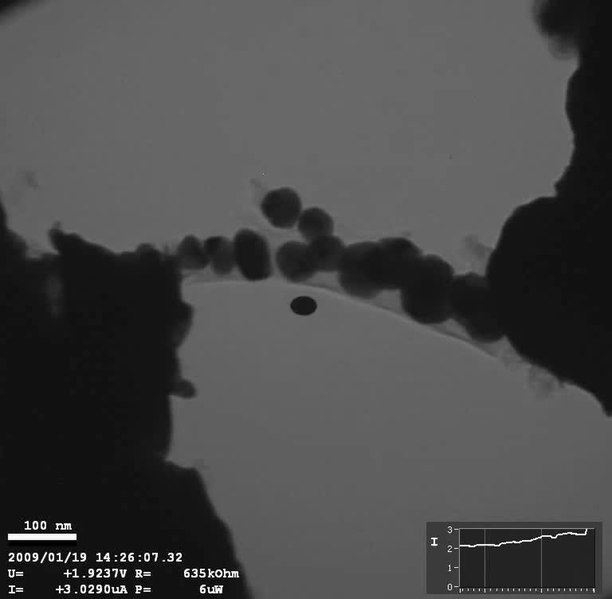Silver nanoparticles are nanoparticles of silver, i.e. silver particles of between 1Â nm and 100Â nm in size. While frequently described as being 'silver' some are composed of a large percentage of silver oxide due to their large ratio of surface-to-bulk silver atoms.
Synthesis

There are many different synthetic routes to silver nanoparticles. They can be divided into three broad categories: physical vapor deposition, ion implantation, or wet chemistry.
Ion implantation
Although it may seem counter-intuitive, ion implantation has been used to create silver nanoparticles. This process has been shown to produce silver particles embedded in glass, polyurethane, silicone, polyethylene, and polymethylmethacrylate. The particles grow in the substrate with the bombardment of ions. The existence of nanoparticles is proven with optical absorbance, though the exact nature of the particles created with this method is not known.
Wet chemistry
There are several wet chemical methods for creating silver nanoparticles. Typically, they involve the reduction of a silver salt such as silver nitrate with a reducing agent like sodium borohydride in the presence of colloidal stabilizer. Sodium borohydride has been used with polyvinyl alcohol, poly(vinylpyrrolidone), bovine serum albumin (BSA), citrate and cellulose as stabilizing agents. In the case of BSA, the sulfur-, oxygen- and nitrogen-bearing groups mitigate the high surface energy of the nanoparticles during the reduction. The hydroxyl groups on the cellulose are reported to help stabilize the particles. Polydopamine-coated magnetic-bacterial cellulose contains multifunctional groups, which acts as a reducing agent for in situ preparation of reusable antibacterial Ag-nanocomposites. Citrate and cellulose have been used to create silver nanoparticles independent of a reducing agent as well. An additional novel wet chemistry method used to create silver nanoparticles took advantage of D-glucose as a reducing sugar and a starch as the stabilizer and also cellulose molecular chain is applied to employ the reducing and stabilizing features of cellulose to synthesize nano silver.
Uses

Samsung has created and marketed a material called Silver Nano, that includes silver nanoparticles on the surfaces of household appliances.
Health concerns
.jpg/120px-Ink_viscosity_as_function_of_temperature_(ink_A).jpg)
Exposure to silver nanoparticles has been associated with "inflammatory, oxidative, genotoxic, and cytotoxic consequences"; the silver particulates primarily accumulate in the liver. but have also been shown to be toxic in other organs including the brain. Nano-silver applied to tissue-cultured human cells leads to the formation of free radicals, raising concerns of potential health risks.
- Allergic reaction: While there is anecdotal evidence suggesting the possibility of a silver allergy, an extensive review of the medical literature does not lend any credence to this possibility. Some silver alloys that include nickel do elicit an allergic reaction.
- Argyria and staining: Ingested silver or silver compounds, including colloidal silver, can cause a condition called argyria, a discoloration of the skin and organs.In 2006, there was a case study of a 17-year-old man, who sustained burns to 30% of his body, and experienced a temporary bluish-grey hue after several days of treatment with Acticoat, a brand of wound dressing containing silver nanoparticles. Argyria is the deposition of silver in deep tissues, a condition that cannot happen on a temporary basis, raising the question of whether the cause of the man’s discoloration was argyria or even a result of the silver treatment. Silver dressings are known to cause a “transient discoloration†that dissipates in 2â€"14 days, but not a permanent discoloration.
- Silzone heart valve: St. Jude Medical released a mechanical heart valve with a silver coated sewing cuff (coated using ion beam-assisted deposition) in 1997. The valve was designed to reduce the instances of endocarditis. The valve was approved for sale in Canada, Europe, the United States, and most other markets around the world. In a post-commercialization study, researchers showed that the valve prevented tissue ingrowth, created paravalvular leakage, valve loosening, and in the worst cases explantation. After 3 years on the market and 36,000 implants, St. Jude discontinued and voluntarily recalled the valve.


0 komentar :
Posting Komentar